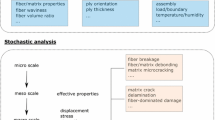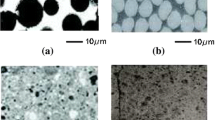Abstract
A novel statistical second-order reduced multiscale (SSRM) approach is established for nonlinear composite materials with random distribution of grains. For these composites considered in this work, the complex microstructure of grains, including their shape, orientation, size, spatial distribution, volume fraction and so on, results in changing of the macroscopic mechanical properties. The first- and second-order unit cell functions based on two-scale asymptotic expressions are constructed at first. Then, the expected homogenized parameters are defined, and the nonlinear homogenization equation on global structure is established, successively. Further, an effective reduced model format for analyzing second-order nonlinear unit cell problem with less computation cost is introduced in detail. Finally, some numerical examples for the materials with varying distribution models are evaluated and compared with the data by theoretical models and experimental results. These examples illustrate that the proposed SSRM approaches are effective for predicting the macroscopic properties of the random composite materials and supply a potential application in actual engineering computation.
Graphic Abstract





















Similar content being viewed by others
References
Kuznetsov, S., Fish, J.: Mathematical homogenization theory for electroactive continuum. Int. J. Numer. Meth. Eng. 91, 1199–1226 (2012)
Christensen, R.M.: A critical evaluation for a class of micro-mechanics models. J. Mech. Phys. Solids 38(3), 379–404 (1990)
Bensoussan, A., Lions, J.L., Papanicolaou, G.: Asymptotic Analysis for Periodic Structures. American Mathematical Society, Rhode Island (2011)
Oleinik, O.A., Shamaev, A.S., Yosifian, G.A.: Mathematical Problems in Elasticity and Homogenization. North-Holland, Amsterdam (1992)
Jikov, V.V., Kozlov, S.M., Oleinik, O.A.: Homogenization of Differential Operators and Integral Functions. Springer, Berlin (1994)
Li, Z.H., Ma, Q., Cui, J.Z.: Second-order two-scale finite element algorithm for dynamic thermo-mechanical coupling problem in symmetric structure. J. Comput. Phys. 314, 712–748 (2016)
Chu, S.: Guilleminot, J.: Stochastic multiscale modeling with random fields of material properties defined on nonconvex domains. Mech. Res. Commun. 97, 39–45 (2019)
Ee, W., Engquist, B.: The heterogenous multiscale methods. Commun. Math. Sci. 1, 87–132 (2003)
Abdulle, A., Nonnenmacher, A.: Adaptive finite element heterogeneous multiscale method for homogenization problems. Comput. Methods Appl. Mech. Engrg. 200, 2710–2726 (2011)
Allaire, G.: Homogenization and two-scale convergence. SIAM J. Math. Anal. 23(6), 1482–1518 (2003)
Hou, T.Y., Wu, X.H.: A multiscale finite element method for elliptic problems in composite materials and porous media. J. Comput. Phys. 134, 169–189 (1997)
Zhang, H.W., Wu, J.K., Fu, Z.D.: Extended multiscale finite element method for elasto-plastic analysis of 2D periodic lattice truss materials. Comput. Mech. 45, 623–635 (2010)
Hughes, T.J.R.: Multiscale phenomena: Green’s functions, the Dirichlet-to-Neumann formulation, subgrid scale models, bubbles and the origins of stabilized methods. Comput. Methods Appl. Mech. Engrg. 127, 387–401 (1995)
Zabaras, N., Ganapathysubramanian, B.: A stochastic multiscale framework for modeling flow through random heterogeneous porous media. J. Comput. Phys. 228, 591–618 (2009)
Zhang, S., Oskay, C.: Reduced order variational multiscale enrichment method for elasto-viscoplastic problems. Comput. Methods Appl. Mech. Engrg. 300, 199–224 (2016)
Geers, M.G.D., Kouznetsova, V., Brekelmans, W.A.M.: Gradient-enhanced computational homogenization for the micro-macro scale transition. J. de Physique IV 11, 145–152 (2001)
Yu, X.G., Cui, J.Z.: The prediction on mechanical properties of 4-step braided composites via two-scale method. Compos. Sci. Technol. 67, 471–480 (2007)
Guan, X.F., Liu, X., Jia, X., et al.: A stochastic multiscale model for predicting mechanical properties of fiber reinforced concrete. Int. J. Solids Struct. 56–57, 280–289 (2015)
Yang, Z.Q., Sun, Y., Cui, J.Z., et al.: A multiscale algorithm for heat conduction-radiation problems in porous materials with quasi-periodic structures. Commun. Comput. Phys. 24, 204–233 (2018)
Yang, Z.Q., Cui, J.Z., Sun, Y.: Transient heat conduction problem with radiation boundary condition of statistically inhomogeneous materials by second-order two-scale method. Int. J. Heat Mass. Tran. 100, 362–377 (2016)
Allaire, G., Habibi, Z.: Second order corrector in the homogenization of a conductive-radiative heat transfer problem. Discret Contin. Dyn.-B 18(1), 1–36 (2013)
Bourgat, J.F.: Numerical experiments of the homogenization method for operators with periodic coefficients. in: Computing Methods in Applied Sciences and Engineering, pp. 330–356, Springer, Berlin (1979)
Gambin, B., Kroner, E.: Higher-order terms in the homogenized stress-strain relation of periodic elastic media. Phys. Stat. Sol. 151, 513–519 (1989)
Bacigalupo, A.: Second-order homogenization of periodic materials based on asymptotic approximation of the strain energy: formulation and validity limits. Meccanica 49, 1407–1425 (2014)
Smyshlyaev, V.P., Cherednichenko, K.D.: On rigorous derivation of strain gradient effects in the overall behavior of periodic heterogeneous media. J. Mech. Phys. Solids 48, 1325–1357 (2000)
Boutin, C., Auriault, J.L.: Dynamic behaviour of porous media saturated by a viscoelastic fluid. Application to bituminous concretes. Int. J. Eng. Sci. 28(11), 1157–1181 (1990)
Fish, J., Kuznetsov, S.: Computational continua. Int. J. Numer. Meth. Eng. 84, 774–802 (2010)
Ameen, M.M., Peerlings, R.H.J., Geers, M.G.D.: A quantitative assessment of the scale separation limits of classical and higher-order asymptotic homogenization. Eur. J. Mech. A 71, 89–100 (2018)
Coenen, E.W.C., Kouznetsova, V., Geers, M.G.D.: Computational homogenization for heterogeneous thin sheets. Int. J. Numer. Meth. Eng. 83(8–9), 1180–1205 (2010)
Kouznetsova, V., Geers, M.G.D., Brekelmans, W.A.M.: Multi-scale constitutive modelling of heterogeneous materials with a gradient-enhanced computational homogenization scheme. Int. J. Numer. Meth. Eng. 54, 1235–1260 (2002)
Anthoine, A.: Second-order homogenization of functionally graded materials. Int. J. Solids Struct. 47(11–12), 1477–1489 (2010)
Goupee, A.J., Vel, S.S.: Multiscale thermoelastic analysis of random heterogeneous materials Part II: Direct micromechanical failure analysis and multiscale simulations. Comp. Mater. Sci. 48, 39–53 (2010)
Brahim-Otsmane, S., Francort, G., Murat, F.: Homogenization in Thermoelasticity in Random Media and Composites. SIAM Press, Philadelphia (1988)
Khan, K.A., Barello, R., Muliana, H., et al.: Coupled heat conduction and thermal stress analyses in particulate composites. Mech. Mater. 43, 608–625 (2011)
Clément, A., Soize, C., Yvonnet, J.: Uncertainty quantification in computational stochastic multiscale analysis of nonlinear elastic materials. Comput. Methods Appl. Mech. Eng. 254, 61–82 (2013)
Sokolowski, D., Kamiński, M.: Homogenization of carbon/polymer composites with anisotropic distribution of particles and stochastic interface defects. Acta Mech. 229(9), 3727–3765 (2018)
Trovalusci, P., Ostoja-Starzewski, M., Laur De Bellis, M., et al.: Scale-dependent homogenization of random composites as micropolar continua, Eur. J. Mech.-A/Solids 49, 396–407 (2015)
Trovalusci, P., Laur De Bellis, M., Ostoja-Starzewski, M., et al.: Particulate random composites homogenized as micropolar materials. Meccanica 49, 2719–2727 (2014)
Mosby, M., Matous, K.: Computational homogenization at extreme scales. Extreme Mech. Lett. 6, 68–74 (2016)
Aboudi, J.: A continuum theory for fiber-reinforced elasticviscoplastic composites. Int. Eng. Sci. 20, 605–621 (1982)
Ghosh, S., Moorthy, S.: Elastic-plastic analysis of heterogeneous microstructures using the voronoi cell finite element method. Comput Meth. Appl. Mech. Eng. 121(1–4), 373–409 (1995)
Dvorak, G.J.: Transformation field analysis of inelastic composite materials. Proc. R Soc. Lond A 437, 311–327 (1992)
Fritzen, F., Leuschner, M.: Reduced basis hybrid computational homogenization based on a mixed incremental formulation. Comput. Methods Appl. Mech. Eng. 260, 143–154 (2013)
Moulinec, H., Suquet, P.: A numerical method for computing the overall response of nonlinear composites with complex microstructure. Comput. Methods Appl. Mech. Eng. 157, 69–94 (1998)
Oliver, J., Caicedo, M., Huespe, A.E., et al.: Reduced order modeling strategies for computational multiscale facture. Comput. Methods Appl. Mech. Eng. 313(1), 560–595 (2017)
Fritzen, F., Böhlke, T.: Reduced basis homogenization of viscoelastic composites. Compos. Sci. Technol. 76, 84–91 (2013)
Zhang, S., Oskay, C.: Reduced order variational multiscale enrichment method for thermo-mechanical problems. Comput. Mech. 59(6), 887–907 (2017)
Bhattacharjee, S., Matouš, K.: A nonlinear manifold-based reduced order model for multiscale analysis of heterogeneous hyperelastic materials. J. Comput. Phys. 313, 635–653 (2016)
Kamiński, M., Figiel, Ł: Effective elastoplastic properties of the periodic composites. Comput. Math. Sci. 22(3–4), 221–239 (2001)
Yuan, Z., Fish, J.: Multiple scale eigendeformation-based reduced order homogenization. Comput. Methods Appl. Mech. Engrg. 198, 2016–2038 (2009a)
Yuan, Z., Fish, J.: Hierarchical model reduction at multiple scales. Int. J. Numer. Meth. Engng. 79, 314–339 (2009b)
Fish, J., Yang, Z.Q., Yuan, Z.F.: A second-order reduced asymptotic homogenization approach for nonlinear periodic heterogeneous materials. Int. J. Numer. Meth. Eng. 119, 469–489 (2019)
Yu, Y., Cui, J.Z., Han, F.: An effective computer generation method for the composites with random distribution of large numbers of heterogeneous grains. Compos. Sci. Technol. 68, 2543–2550 (2008)
Li, Y.Y., Cui, J.Z.: The multiscale computational method for mechanics parameters of the materials with random distribution of multiscale grains. Compos. Sci. Technol. 65, 1447–1458 (2005)
Xu, M.: A Study on Nonlinear Constitutive Law and FEA of Rubber-like Hyperelastic Materials, Beihang University (2002)
Smith, J.C.: Experimental values for the elastic constants of a particulate-filled glassy polymer. J. Res. NBS 80A, 45–49 (1976)
Richard, T.G.: The mechanical behavior of a solid microsphere filled composite. J. Comp. Mat. 9, 108–113 (1975)
Hobbs, D.W.: The dependence of the bulk modulus, Young’s modulus, creep, shrinkage and thermal expansion of concrete upon aggregate volume concentration. Matériaux et Construction 4(2), 107–114 (1971)
Chou, T.W., Nomura, S., Taya, M.: A self-consistent approach to the elastic stiffness of short-fibre composites. J. Compos. Mater. 14, 178–188 (1980)
Habibnejad-Korayem, M., Mahmudi, R., Poole, W.J.: Enhanced properties of Mg-based nano-composites reinforced with Al2O3 nano-particles. Mater. Sci. Eng. A 519(1–2), 198–203 (2009)
Goldman, N.L., Hutchinson, J.W.: Fully plastic crack problems: the center-cracked strip under plane strain. Int. J. Solids Struct. 11(5), 575–591 (1975)
Hutchinson, J.W.: Plastic stress and strain fields at a crack tip. J. Mech. Phys. Solids 16(5), 337–342 (1968)
Yuan, Z.: Multiscale Design System, [Ph.D Thesis], Rensselaer Polytechnic Institute. Troy, NY (2008)
Acknowledgement
This study was funded by the National Natural Science Foundation of China (Grant 11701123) and Fundamental Research Funds for the Central Universities (Grant HIT.NSRIF.2020017).
Author information
Authors and Affiliations
Corresponding authors
Additional information
Publisher's Note
Springer Nature remains neutral with regard to jurisdictional claims in published maps and institutional affiliations.
Executive Editor: Zi-Shun Liu
Appendices
Appendix A
Inserting Eqs. (3)–(5) into Eq. (1), and considering the coefficients of the same power for \(\xi\) yields
Next, comparing the coefficient of \(\xi^{0}\) on both sides of (A.1) and using the homogenization Eq. (13) yield to
Appendix B
In this work, continuum damage mechanic with isotropic damage law is applied to model constitutive behaviors of microconstituents. By this method, the constitutive relations are described by
where \(\omega_{ph} \in [0,1]\) is a damage state variable. Therefore, the partitioned eigenstrains are introduced by
The damage state variables \(\omega_{{\text{ph}}}^{(\alpha )}\) are the piecewise-continuous functions of damage equivalent strains \(\kappa_{{\text{ph}}}^{(\alpha )}\). The evolutions of phase damage are introduced by
where \({}^{1}\kappa_{{\text{ph}}}^{(\alpha )}\) and \({}^{2}\kappa_{{\text{ph}}}^{(\alpha )}\) are the parameters about the initial and fully damaged state, respectively. Also, we can refer to Ref. [63] for various \(\Phi (\kappa_{{\text{ph}}}^{(\alpha )} )\). The damage equivalent strain \(\kappa_{{\text{ph}}}^{(\alpha )}\) are supposed to be a function of the principal strain
where
and C is the compression factor. \({}^{1}\kappa_{{\text{ph}}}^{(\alpha )}\) is determined by material strength S and stiffness E by
According to the selection of damage evolution functions, \({}^{2}\kappa_{{\text{ph}}}^{(\alpha )}\) can be expressed in accordance with physical-based material parameters (E, S and G-the strain energies).
Rights and permissions
About this article
Cite this article
Yang, Z., Sun, Y., Liu, Y. et al. Prediction on nonlinear mechanical performance of random particulate composites by a statistical second-order reduced multiscale approach. Acta Mech. Sin. 37, 570–588 (2021). https://doi.org/10.1007/s10409-020-01025-3
Received:
Revised:
Accepted:
Published:
Issue Date:
DOI: https://doi.org/10.1007/s10409-020-01025-3




